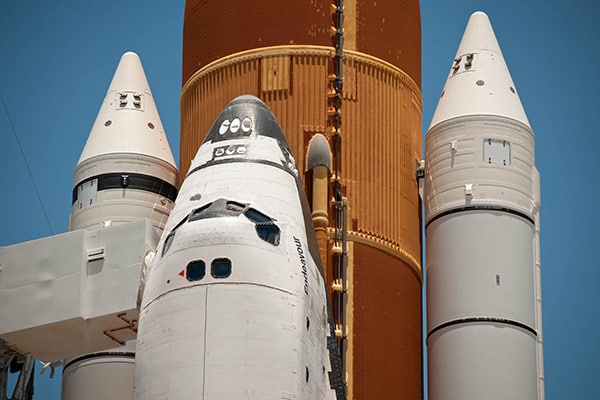
The Trump Administration’s decision to create a new branch of the US military, the Space Force, the sixth of its armed forces, is more a matter of organisation than of content. But it is another policy announcement in line with America First, asserting the primacy of the US in this area too, or rather in this space, which is becoming increasingly prominent. Without wishing to underplay the importance of its activities, a good deal of what the new force is set to do was already being done under other guises. More than anything, the US aims to prolong its dominance in this field vis-à-vis China and Russia. The three nations are the only powers with an armed space capability of any calibre. Europe is not among them, despite its space programme; various countries are watching closely, however, including Spain with its forthcoming Space Surveillance Operations Centre (COVE), part of the Spanish Air Force. India may become a player in time.
Trump himself was the first to refer to the plans a year ago. It will be the first new branch of the armed forces to be created in the last 71 years, provided it receives the blessing of Congress. The latter can exercise its veto given its power to set the budget, which is particularly significant when the Trump Administration is asking for an extra US$8 billion to be earmarked over the next five years. Previously, the newest branch was the US Air Force (USAF), created in 1947, which up till now has been responsible for space, GPS and other capabilities. The other four US services are the Army, Coast Guard, Marine Corps and Navy.
The fact that a Space Force as such has not existed until now does not mean that the US underrated the issue. Indeed, in 2011 the Obama Administration published its National Security Space Strategy, featuring all the necessary elements and geared towards a pragmatic approach that discounted the formation of a new force per se. The current Defense Secretary, Jim Mattis, before starting at the Pentagon, had publicly criticised the idea on the grounds that it would lead to a ‘narrower and even more parochial’ focus on operations in space. There is much of the superficial in inviting people to vote for the logo of the new force from among six candidates.
Space has taken on a strategic importance for military and civil communications and is an area with both strengths and weaknesses. A race is underway in anti-satellite capabilities, given that the loss of satellites would render both armed forces and society at large blind, deaf and dumb. Many capabilities, both civilian and military, now depend on GPS and communication satellites, including drones, which have acquired great importance in a range of fields. China still depends on the GPS system of the US but hopes to have weaned itself off by 2020 with its own constellation of 35 satellites. According to a US intelligence report, in two to three years Russia and China could become capable of downing US satellites. In 2007 China conducted a successful test in which it fired a missile at one of its own satellites and is immersed in a civil and military space programme that is nothing if not strategic. In Russia, Putin has boasted of developing a hypersonic vehicle that can be launched into space, cruising in the earth’s atmosphere and eluding anti-missile and radar defences. The US has its X-37B long-range spaceplane programme. Russia has had a space force at times (between 1992 and 1997 and 2001 and 2011) but command has now passed to the Russian Aerospace Forces, or VKS, which include its air force. For its part, China has a Space Systems department within its armed forces and a Strategic Support Force dedicated to these goals.
This summer it was the Vice-President, Mike Pence, whose task it was to announce the launch of the process to create the Space Force, while the Pentagon issued a report on the subject, consistent with the recent National Security Strategy and the National Strategy for Space released by the White House. This proposes to ‘transform to more resilient space architectures; strengthen deterrence and warfighting options; improve foundational capabilities, structure, and processes; and foster conducive domestic and international environments for space development’.
The plan, which aims to have the new branch in operation by 2020, includes the creation of a space command, a Space Operations Force, made up of elite troops and officers specialised in the space field (a sort of special space service), a Space Development Agency and a new post of Deputy Defense Secretary for space. ‘It’s not enough to have an American presence in space. We must have American dominance in space’, said Pence at the unveiling of the plan. The goal, according to Pence, is to halt and counteract, ‘deter and if necessary degrade’ the military progress made in space by the US’s adversaries such as Russia and China. ‘Our adversaries have transformed space into a war-fighting domain already’. Peace, he added, ‘only comes through strength, and in the realm of outer space, the United States Space Force will be that strength in the years ahead’.
Does this entail a greater militarisation of space? Mattis rejects the idea. But it will be difficult for the US to avoid it if the proposal prospers in Congress. The US is a signatory to the 1967 Outer Space Treaty, which bans the deployment of weapons of mass destruction in space and stipulates that the moon (the dark side of which China is planning to explore) and other heavenly bodies may be used only for peaceful ends. The Pentagon’s text says that the Department of Defense ‘will usher in a new age of space technology and field new multi-domain systems in order to deter and if necessary degrade, deny, disrupt, destroy, and manipulate adversary capabilities to protect US interests, assets, and way of life. This new age will unlock growth in the US industrial base, expand the commercial space economy, and strengthen cooperation with our allies and partners’.
There will be a new ‘acceleration of capabilities’ in this field, with other parts of the world being involved, for instance Argentina by hosting China’s large antenna in Patagonia, and India. It is part of the great technology struggle being fought out by the great powers. The space race is turning into one of their tussles. Globalisation and its control do not (yet) operate on a cosmic scale, but they do extend as far as outer space. A vertical axis is thus added to the horizontal one.

